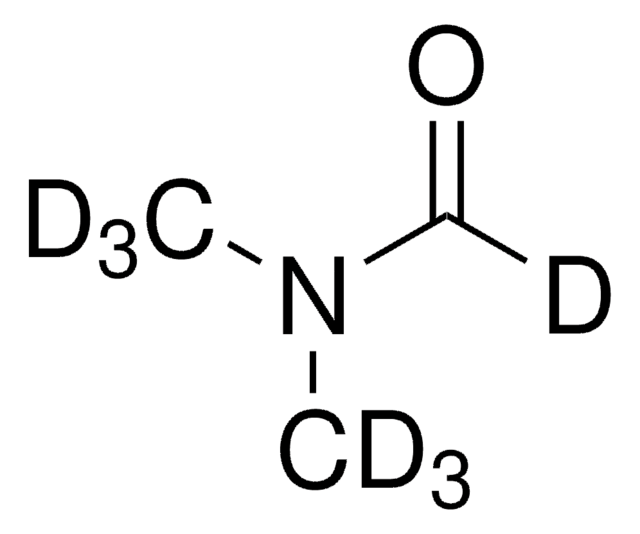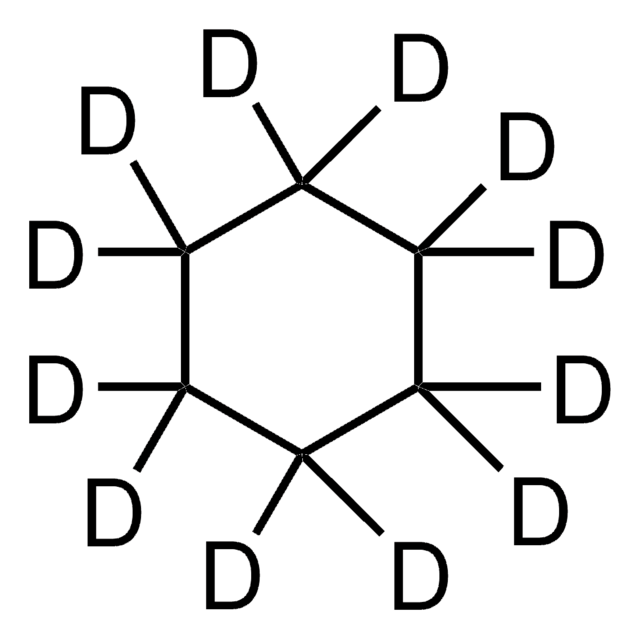437727
Tétrahydrofurane-d8
≥99.5 atom % D, contains 0.03 % (v/v) TMS
Synonyme(s) :
Octadeutérotétrahydrofurane, Tétrahydrofurane deutéré
About This Item
Produits recommandés
Pureté isotopique
≥99.5 atom % D
Niveau de qualité
Pureté
≥99% (CP)
Forme
liquid
Contient
0.03 % (v/v) TMS
Technique(s)
NMR: suitable
Impuretés
≤0.03% water
water
Indice de réfraction
n20/D 1.403 (lit.)
Point d'ébullition
65-66 °C (lit.)
Pf
−106 °C (lit.)
Densité
0.985 g/mL at 25 °C (lit.)
Changement de masse
M+8
Température de stockage
2-8°C
Chaîne SMILES
[2H]C1([2H])OC([2H])([2H])C([2H])([2H])C1([2H])[2H]
InChI
1S/C4H8O/c1-2-4-5-3-1/h1-4H2/i1D2,2D2,3D2,4D2
Clé InChI
WYURNTSHIVDZCO-SVYQBANQSA-N
Vous recherchez des produits similaires ? Visite Guide de comparaison des produits
Description générale
Application
- Experimental and Theoretical Study of CO2 Insertion into Ruthenium Hydride Complexes.: This research provides insights into the mechanistic pathways for CO2 reactivity with ruthenium hydride complexes, potentially relevant for catalytic applications including transformations involving Tetrahydrofuran-d₈ (Ramakrishnan et al., 2016).
- Syntheses, structures, and NMR chemical shifts of a family of trimethyltin alkoxide, amide, halide and cyclopentadienyl compounds.: Details the synthesis and structural characterization of trimethyltin compounds, useful for understanding the coordination chemistry that may involve Tetrahydrofuran-d₈ as a solvent or structural analogue (Lichtscheidl et al., 2015).
- NMR studies of coupled low- and high-barrier hydrogen bonds in pyridoxal-5′-phosphate model systems in polar solution.: Discusses the application of NMR spectroscopy in studying hydrogen bonding interactions, where Tetrahydrofuran-d₈ could be utilized as a deuterated solvent for enhanced spectral clarity (Sharif et al., 2007).
- Stable hydrocarbon diradical, an analogue of trimethylenemethane.: Investigates stable hydrocarbon diradicals, where Tetrahydrofuran-d₈ may be used as part of the experimental setup to stabilize reactive intermediates or as a solvent to study radical stability (Rajca et al., 2005).
Produits recommandés
Mention d'avertissement
Danger
Mentions de danger
Conseils de prudence
Classification des risques
Acute Tox. 4 Oral - Carc. 2 - Eye Irrit. 2 - Flam. Liq. 2 - STOT SE 3
Organes cibles
Central nervous system, Respiratory system
Risques supp
Code de la classe de stockage
3 - Flammable liquids
Classe de danger pour l'eau (WGK)
WGK 1
Point d'éclair (°F)
1.4 °F - closed cup
Point d'éclair (°C)
-17 °C - closed cup
Faites votre choix parmi les versions les plus récentes :
Déjà en possession de ce produit ?
Retrouvez la documentation relative aux produits que vous avez récemment achetés dans la Bibliothèque de documents.
Les clients ont également consulté
Notre équipe de scientifiques dispose d'une expérience dans tous les secteurs de la recherche, notamment en sciences de la vie, science des matériaux, synthèse chimique, chromatographie, analyse et dans de nombreux autres domaines..
Contacter notre Service technique














